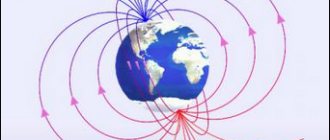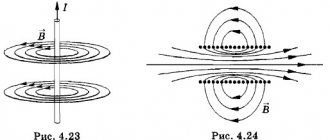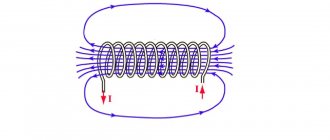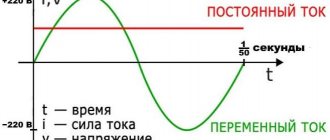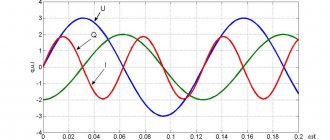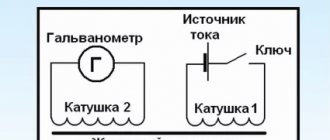Magnetic induction is a force characteristic of a magnetic field at a selected point in space. It determines the force with which the magnetic field acts on a charged particle that moves inside it. Magnetic induction is considered a fundamental characteristic of a magnetic field (like strength for an electric field).
Magnetic induction describes the magnetic force (vector) on a test object (for example, a piece of iron) at each point in space. In simple words, if a natural magnet is brought near magnetic substances (such as iron, nickel, cobalt, etc.), it will induce magnetic properties in them, which is called “magnetic induction”. Magnetic induction is used to create artificial magnets.
Magnetic induction is also called magnetic flux density.
Magnetic induction is measured:
- in the SI system the unit is tesla (T),
- in the GHS system the unit is Gauss (Gs).
The relationship between T and G: 1 T = 10,000 G.
Magnetic induction is a vector quantity and is denoted by the letter B with an arrow:
Induction (from Latin inducere - introduce, induce) - the production of currents in a circuit under the influence of a magnet or other current.
Tesla as a unit of measurement:
Tesla is a unit of measurement of magnetic flux density, magnetic field strength and induction in the International System of Units (SI), named after the inventor Nikola Tesla.
Tesla as a unit of measurement has a Russian designation - Tl and an international designation - T.
1 tesla is equal to the induction of such a uniform magnetic field in which a force of 1 newton acts on 1 meter of length of a straight conductor perpendicular to the magnetic induction vector with a current of 1 ampere. In other words, one tesla is equal to the field strength acting on a conductor with a force of one newton per meter of conductor at a current strength for each ampere of current.
Likewise, one tesla represents a magnetic flux density of one weber per square meter of area.
T = kg / (s2 A) = N / (A m) = Wb / m2.
1 T = 1 kg / (1 s2 · 1 A) = 1 N / (1 A · 1 m) = 1 Wb / 1 m2.
Tesla was introduced into the International System of Units by the decision of the XI General Conference on Weights and Measures in 1960, simultaneously with the adoption of the SI system as a whole. In accordance with the SI rules regarding derived units named after scientists, the name of the unit “tesla” is written with a lowercase letter, and its designation is written with a capital letter (T). This spelling of the designation is also preserved in the designations of derived units formed using an adze.
Physical meaning of magnetic induction
Physically, this phenomenon is explained as follows. The metal has a crystalline structure (the coil is metal). The crystal lattice of a metal contains electrical charges - electrons. If there is no magnetic influence on the metal, the charges (electrons) are at rest and do not move anywhere.
Dmitry Petrovich VasilievProfessor of Electrical Engineering, St. Petersburg State Polytechnic University If a metal comes under the influence of an alternating magnetic field (due to the movement of a permanent magnet inside the coil - an exact displacement), then the charges begin to move under the influence of this magnetic field.
As a result, an electric current is generated in the metal. The strength of this current depends on the physical properties of the magnet and coil and the speed of movement of one relative to the other.
When a metal coil is placed in a magnetic field, the charged particles of the metal lattice (in the chestnut) are rotated through a certain angle and placed along the magnetic field lines.
The greater the magnetic field strength, the greater the number of particles rotating and the more uniform their arrangement will be.
Magnetic fields oriented in one direction do not neutralize each other, but add up to a single field.
Multiples and submultiples of tesla:
Multiples and submultiples are formed using standard SI prefixes.
| Multiples | Dolnye | ||||||
| magnitude | Name | designation | magnitude | Name | designation | ||
| 101 T | decatesla | yesTl | daT | 10−1 T | decitesla | dTl | dT |
| 102 T | hectotesla | gTl | hT | 10−2 T | centitesla | stl | cT |
| 103 T | kilotesla | kT | kT | 10−3 T | millitesla | mTl | mT |
| 106 T | megatesla | MTL | M.T. | 10−6 T | microtesla | µT | µT |
| 109 T | gigatesla | GTL | GT | 10−9 T | nanotesla | nTl | nT |
| 1012 T | teratesla | TTL | TT | 10−12 T | picotesla | pTl | pT |
| 1015 T | petatesla | PTl | P.T. | 10−15 T | femtotesla | ftl | fT |
| 1018 T | exatesla | ETL | ET | 10−18 T | attotesla | atl | aT |
| 1021 T | zettatesla | ZTL | ZT | 10−21 T | zeptotesla | ztl | zT |
| 1024 T | iottatesla | ITl | YT | 10−24 T | ioctotesla | iTl | yT |
Magnetic flux
Magnetic flux is a scalar quantity that characterizes the effect of magnetic induction on a given metal circuit.
Magnetic induction is determined by the number of lines of force crossing 1 cm2 of metal section.
The magnetometers used to measure it are called teslometers.
Abramyan Evgeniy Pavlovich Associate Professor, Department of Electrical Engineering, St. Petersburg State Polytechnic University The unit of measurement of magnetic induction in the SI system is Tesla (T).
After the movement of electrons in the coil stops, the core, if it is made of soft iron, loses its magnetic properties. If it is made of steel, it may retain its magnetic properties for some time.
Magnet interaction
A permanent magnet (or magnetic needle) is oriented along the Earth's magnetic meridian. The end pointing north is called the north pole (N), and the opposite end is called the south pole (S). Bringing two magnets closer, we notice that like poles repel each other, and opposite ones attract (Fig. 1).
If we separate the poles by cutting a permanent magnet into two parts, we will find that each of them will also have two poles, that is, it will be a permanent magnet (Fig. 2). Both poles - north and south - are inseparable from each other, equal.
The magnetic field created by the Earth or permanent magnets is represented, like an electric field, by magnetic lines of force. An image of the magnetic field lines of a magnet can be obtained by placing a sheet of paper on top of it, onto which iron filings are poured in an even layer. When exposed to a magnetic field, sawdust becomes magnetized: each of them has a north and south pole. The opposite poles tend to move closer together, but this is prevented by the friction of the sawdust on the paper. If you touch the paper with your finger, the friction will decrease and the filings will be attracted to each other, forming chains that represent magnetic field lines.
In Fig. Figure 3 shows the position of a straight sawdust magnet in the field and small magnetic arrows indicating the direction of the magnetic field lines. This direction is taken as the direction of the north pole of the magnetic needle.
Observing Spectra
In accordance with the density of magnetic field lines (MF), you can see the magnitude of the induction vector, and according to the direction of the force rows, its flow. Observation of the spectra of the direct current and the coil actually shows that when the conductor is removed, the MF induction decreases quite quickly.
The magnetic background is called:
- With different excretion at different points - heterogeneous. The inhomogeneous background is part of the linear and radial current, outside the solenoid, unchanged magnet, etc.
- With induction at all points - a uniform field. Graphically, such a MF is represented by lines of force, which are considered to be equally spaced parallel parts. This case is the background from inside the long solenoid, as well as the field between close adjacent flat tips of the electromagnet.
The product of the induction of the field penetrating into the circuit from its region is called the MI flux or the elementary MF. The definition was given and studied by the British physicist Faraday. He noted that this concept actually allows us to take a deeper look at the combined nature of magnetic and electrical phenomena.
Denoting the flux by the letter f, the contour area S and the angle between the direction of the induction vector B and the normal part n to the region α, we can write the magnetic flux with the formula:
F = S cos α.
MP is a scalar dimension. For example, since the density of the force lines of a random magnetic field is equal to its induction, it is equalized by the entire number of lines that penetrate the circuit. As the field changes, the flow that permeates the circuit also changes.
The unit of magnetic flux is weber. The definition of an SI jet is considered to be a line whose area is 1 m², located on a uniform background with an induction of 1 W / m2 and perpendicular to the vector. This device will be designated:
1 W = 1 W/m2 – 1 m².
Basic characteristics of the magnetic field used in the SI and SGS systems
The magnetic field has the following main characteristics:
- Tension (H). To measure the value of this vector quantity in the international SI system, amperes per meter (A/m) are used. In the Centimeter-Gram-Second system, Oersteds (E) are used for this. The relationship is as follows: 1 A/m = 4π/103 Oe. 1 A/m ≈ 0.0125663 Oe.
- Induction (B). To measure the value of this vector quantity, Teslas (T) are used in the international SI system. In the Centimeter-Gram-Second system, Gaussians (Gs) are used for this. The relationship is as follows: 1 T = 10,000 Gauss.
The emergence of the concept of magnetic induction
At the dawn of the era of development of electricity, people began to explore related phenomena. Thus, Hans Oersted discovered in 1819 that a current-carrying conductor creates a circular magnetic field around it; Andre-Marie Ampère showed that if the direction of movement of charges coincides, neighboring conductors attract each other. The creation of the Biot-Savart law (domestic sources add Laplace), which describes the magnitude and direction of magnetic induction at a point in space, put an end to the debate. Sources admit a reservation regarding the fact that the research was conducted with direct current.
Relationship between induction and magnetic field strength
Integration (see figure) occurs along the current loop. In the formula, r implies the elementary midpoint of the current segment, r0 is the location of space for which the magnetic induction is calculated. Please note that in the denominator of the fraction behind the integral, two vectors are multiplied. The result is a value, the direction of which is determined by the gimlet rule (left or right hand). Integration is carried out over the contour element dr, r is the midpoint of a small section of the full length. We reduce the identical differences in the numerator and denominator; a unit vector remains at the top, specifying the direction of the result.
The formula shows how to find the field for contours of any shape by integrating over points. Modern numerical methods underlie the action of computer applications (like Maxwell 3D) to solve the corresponding problem. The equation is consistent with the laws of Gauss (magnetic induction) and Ampere (magnetic field circulation). Georg Ohm used knowledge about the compass, deducing a well-known dependence. We obtain the shape of the field lines using magnetic arrows and the force of leaving the direction unchanged (see the note about Ohm's law for a section of the circuit). This will be a picture of magnetic induction in space, which experimentally confirmed the Biot-Savart-Laplace law.
What Ampere did in 1825 allowed him to show: electric current in some cases is an analogue of a permanent magnet. A new model emerged that was more consistent with reality than the Poisson dipole scheme. Such an abstraction explained the absence of isolated magnetic poles in nature. According to modern concepts, a piece of steel becomes magnetized because the dipoles of elementary particles and molecules acquire order. This is the basis for the demagnetization circuits of transformer cores, which cause damped current oscillations before turning off the power. As a result, the effect of orderliness is blurred, the expressed properties disappear.
Electron spin
The presence of a magnetic moment is explained by the existence of spins (the concept was introduced in the 20s of the 20th century) - the angular momentum of particles of the microworld. Real, not abstract things, existence confirmed experimentally (Stern-Gerlach). Spin is a vector quantity, the same for all particles of the same type (for example, electrons), and is described by a special quantum number. The SI unit of measurement is J s, as is the case for another angular momentum (Planck's constant). Sometimes a simplified dimensionless notation is used. Planck's constant is lowered. The spin quantum number (s, ms) is simply indicated.
Due to the presence of spin, an elementary particle acquires a magnetic moment, calculated by the formula: in the numerator, the product of the spin angular momentum by the charge of the particle and the g-factor (constants given in various reference books for certain elementary particles); the denominator is twice the mass of the elementary particle. As you can see, it can be taken into account; the maximum magnetization of a material under given conditions can be calculated in advance. The real triumph of quantum electrodynamics was the prediction of g-factors for some elementary particles.
Michael Faraday's discovery in 1831 of the generation of a circular electric field by an alternating magnetic field showed that the two phenomena are closely related, which was a prerequisite for the creation of Maxwell's (four) equations, a special case of which are most of the formulas in this area, including those mentioned above. Research proceeded as usual, but in slightly different ways. The integration was carried out by Lord Kelvin, known as William Thompson, who showed the presence of H (tension) and B of magnetic induction, the first characterizing the Poisson model, the second the Ampere model.
How is a magnetic field created?
Magnetic fields are created by moving electrically charged particles, i.e. the field appears where electric charges move. For example, passing an electric current through a conductor.
Another way is to combine the electrons' own magnetic fields, which happens in some materials. They are called permanent magnets (for example, the magnets on our refrigerators).
If a very large charge moves at an even higher speed, then the strength of its magnetic field will also increase.
How is magnetic field measured?
The magnetic field is a vector quantity and to measure/determine it you need to know its direction and strength .
To determine the direction, you can place a magnetic compass next to a magnetic object. Thus, the compass needle will stop along the field line.
Magnetic field strength is measured:
1. Either in SI units Tesla (T) or microtesla (μT)
2. Either in units of Gauss (G) or milligauss (mG), still used experimentally.
Where:
- 1 T = 10,000 Gauss
- 1 G = T
- 1 mG = 0.1 µT
Characteristics of the magnetic field
Main characteristics:
- magnetic induction
- magnetic flux
- magnetic permeability
Magnetic induction (B)
This is the intensity of the magnetic field. The stronger a magnet or electromagnet creates a magnetic field, the greater the induction.
Formula: B = Ф / S.cos (
